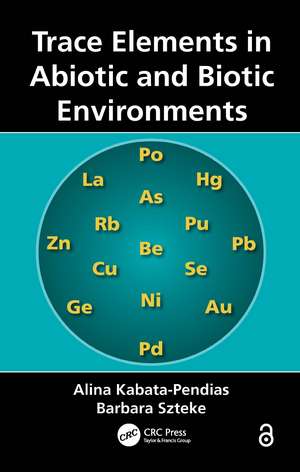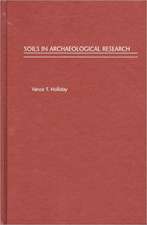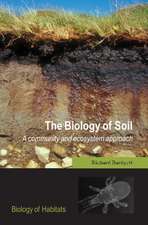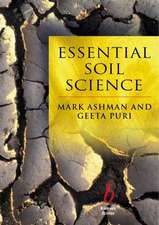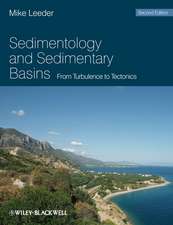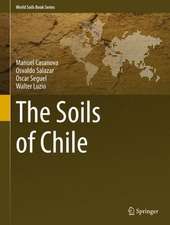Trace Elements in Abiotic and Biotic Environments
Autor Alina Kabata-Pendias, Barbara Sztekeen Limba Engleză Hardback – 7 apr 2015
This book describes the occurrence and behavior of trace elements in rocks, soil, water, air, and plants, and also discusses the anthropogenic impact to the environment. In addition, it covers the presence of trace elements in feeds, as either contaminants or as nutritional or zootechnical additives, and their transfer across the food chain to humans.
Also discussed is international legislation on trace elements for both micronutrients and contaminants in soil and plant food. A special focus is placed on the human health effects of both trace element deficiency and excess. All trace elements are covered—from aluminum to zirconium—as well as rare-earth elements (actinides and lanthanides).
| Toate formatele și edițiile | Preț | Express |
|---|---|---|
| Paperback (1) | 444.80 lei 6-8 săpt. | |
| CRC Press – 30 iun 2021 | 444.80 lei 6-8 săpt. | |
| Hardback (1) | 993.44 lei 6-8 săpt. | |
| CRC Press – 7 apr 2015 | 993.44 lei 6-8 săpt. |
Preț: 993.44 lei
Preț vechi: 1370.40 lei
-28% Nou
Puncte Express: 1490
Preț estimativ în valută:
190.12€ • 197.75$ • 156.95£
190.12€ • 197.75$ • 156.95£
Carte tipărită la comandă
Livrare economică 12-26 aprilie
Preluare comenzi: 021 569.72.76
Specificații
ISBN-13: 9781482212792
ISBN-10: 148221279X
Pagini: 468
Ilustrații: 1 black & white illustrations, 108 black & white tables
Dimensiuni: 156 x 234 x 30 mm
Greutate: 0.82 kg
Ediția:1
Editura: CRC Press
Colecția CRC Press
ISBN-10: 148221279X
Pagini: 468
Ilustrații: 1 black & white illustrations, 108 black & white tables
Dimensiuni: 156 x 234 x 30 mm
Greutate: 0.82 kg
Ediția:1
Editura: CRC Press
Colecția CRC Press
Public țintă
Academic and Professional ReferenceCuprins
Aluminum [Al, 27]. Antimony [Sb, 51]. Arsenic [As, 33]. Barium [Ba, 56]. Beryllium [Be, 4]. Bismuth [Bi, 83]. Boron [B, 5]. Bromine [Br, 35]. Cadmium [Cd, 48]. Cesium [Cs, 55]. Chlorine [Cl, 17]. Chromium [Cr, 24]. Cobalt [Co, 27]. Copper [Cu, 29]. Fluorine [F, 9]. Gallium [Ga, 31]. Germanium [Ge, 32]. Gold [Au, 79]. Hafnium [Hf, 72]. Indium [In, 49]. Iodine [I, 53]. Iridium [Ir, 77]. Iron [Fe, 26]. Lead [Pb, 82]. Lithium [Li, 3]. Manganese [Mn, 25]. Mercury [Hg, 80]. Molybdenum [Mo, 42]. Nickel [Ni, 28]. Niobium [Nb, 41]. Osmium [Os, 76]. Palladium [Pd, 46]. Platinum [Pt, 78]. Polonium [Po, 84]. Radium [Ra, 88]. Radon [Rn, 88]. Rhenium [Re, 75]. Rhodium [Rh, 45]. Rubidium [Rb, 37]. Ruthenium [Ru, 44]. Scandium [Sc, 21]. Selenium [Se, 34]. Silicon [Si, 14]. Silver [Ag, 47]. Strontium [Sr, 38]. Tantalum [Ta, 73]. Technetium [Tc, 43]. Tellurium [Te, 52]. Thallium [Tl, 81]. Tin [Sn, 50]. Titanium [Ti, 22]. Tungsten [W, 74]. Vanadium [V, 23]. Yttrium [Y, 39]. Zinc [Zn, 30]. Zirconium [Zr, 40]. Lanthanides. Actinides.
Notă biografică
Alina Kabata-Pendias is a professor emeritus at the Institute of Soil Science and Plant Cultivation in Puławy, Poland. She earned her PhD in soil science from this institute. She also worked at the Polish Geological Institute in Warsaw. Dr. Kabata-Pendias’s research interest focuses on the fate of trace elements in the rock–soil–plant chain. She has published nearly 320 articles and is the author or coauthor of 11 books. Dr. Kabata-Pendias has been active in various national and international scientific committees and was awarded several medals, including the prestigious Philippe Duchaufour Medal, bestowed by the European Geosciences Union.
Barbara Szteke is a professor emeritus at the Institute of Agricultural and Food Biotechnology in Warsaw, Poland. She also served as head of the Department of Food Analysis at that institute. Dr. Szteke has also been the Polish representative for the Codex Alimentarius Commission FAO/WHO Committee on Food Additives and Contaminants. Dr. Szteke’s research areas focus on foodstuff contaminants coming from the environment, such as elements, pesticides, and mycotoxins. She is the author or coauthor of more than 200 scientific papers, books chapters, reports, and lectures.
Barbara Szteke is a professor emeritus at the Institute of Agricultural and Food Biotechnology in Warsaw, Poland. She also served as head of the Department of Food Analysis at that institute. Dr. Szteke has also been the Polish representative for the Codex Alimentarius Commission FAO/WHO Committee on Food Additives and Contaminants. Dr. Szteke’s research areas focus on foodstuff contaminants coming from the environment, such as elements, pesticides, and mycotoxins. She is the author or coauthor of more than 200 scientific papers, books chapters, reports, and lectures.
Descriere
This book helps readers understand the fundamental principles and phenomena that control the transfer of trace elements. It describes the occurrence and behavior of trace elements in rocks, soil, water, air, and plants, and also discusses the anthropogenic impact to the environment. In addition, the book covers the presence of trace elements in feeds, as either contaminants or as nutritional or zootechnical additives, and their transfer across the food chain to humans. All trace elements are covered—from aluminum to zirconium—as well as rare-earth elements (actinides and lanthanides).
